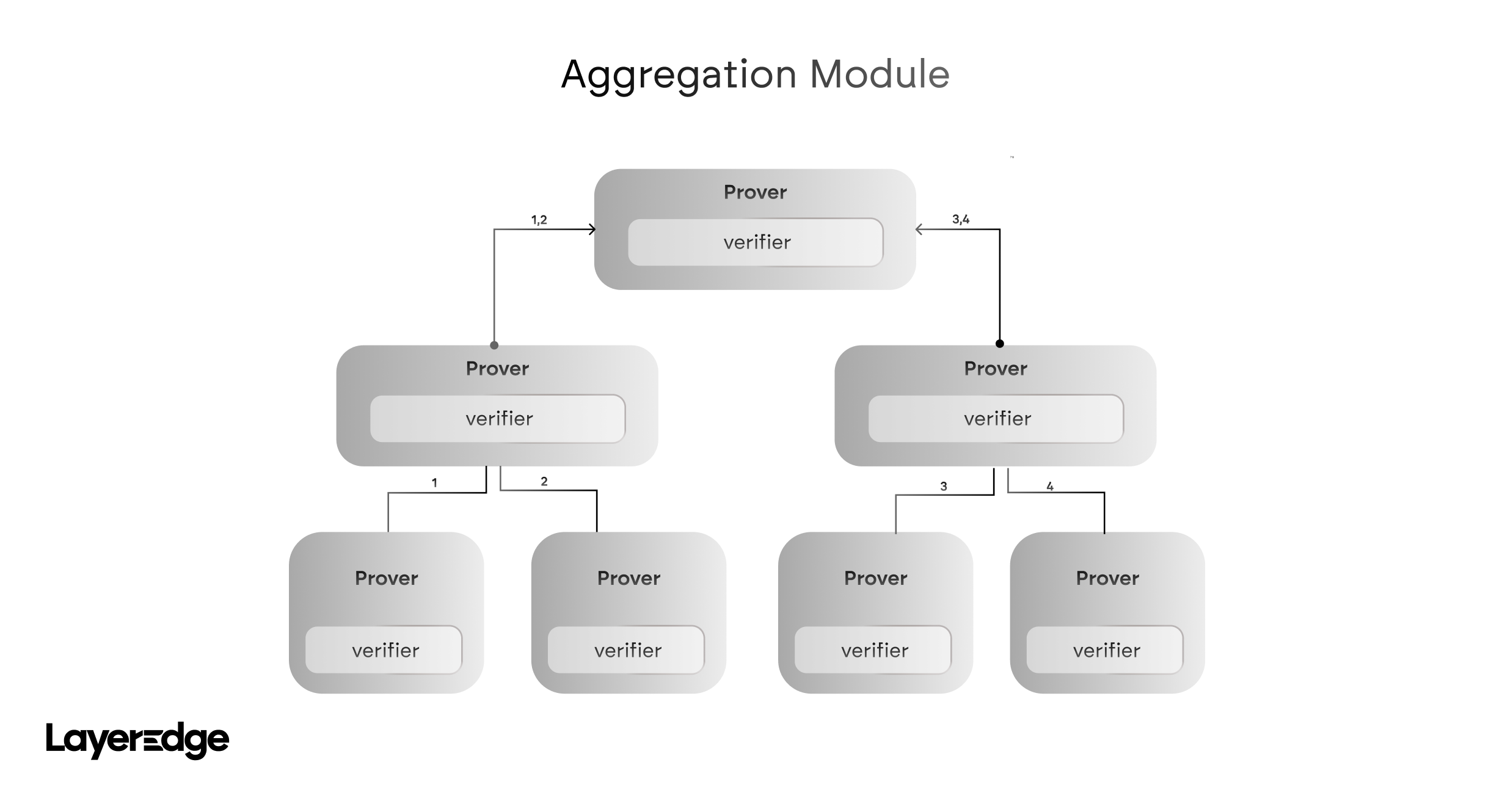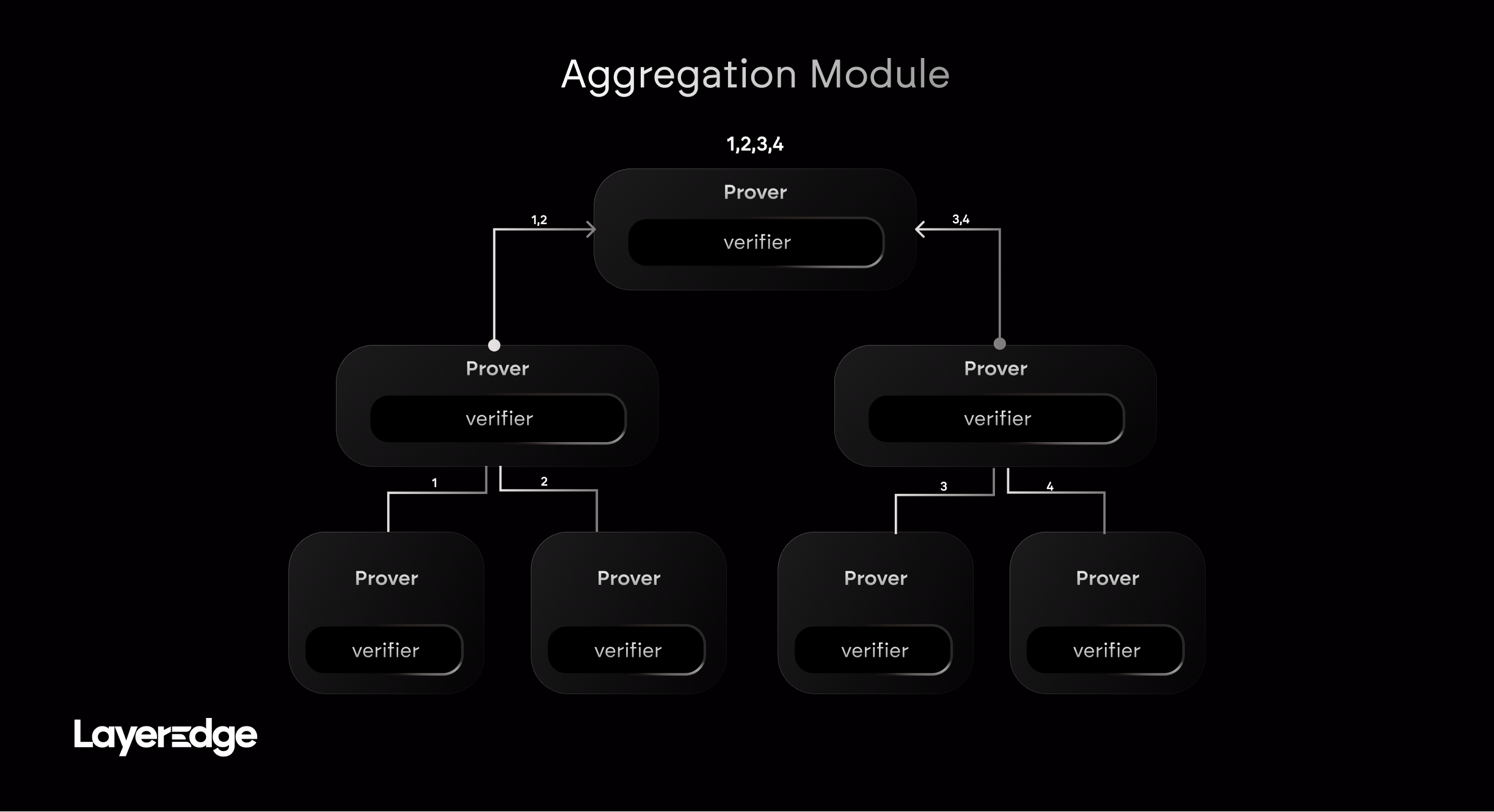General Prover / Verifier System
Purpose and Role
The General Prover / Verifier System is the cryptographic heart of LayerEdge’s verification architecture. It is responsible for recursively aggregating multiple normalized zk-proofs into a single succinct proof, dramatically reducing verification overhead.
By shifting computational effort to provers and compressing proof size, this system enables LayerEdge to provide a universal, scalable, and cost-effective zk-verification layer — verifiable natively on Bitcoin.
This module is essential to:
- Make zk-verification viable at scale
- Minimize on-chain costs and bandwidth
- Allow Bitcoin to act as the universal final settlement layer without needing to verify every individual proof directly


Core Components
1. Aggregation Circuits
Aggregation circuits are special zk-circuits that receive multiple zk-proofs as inputs and output a new, single zk-proof that asserts the correctness of all previous ones.
Each circuit is tailored to balance:
- Prover time
- Constraint efficiency
- Field compatibility
- Recursion depth
2. Recursive Composition Logic
Recursive aggregation is built using binary or fan-in trees, where each level of the tree performs one round of proof aggregation.
- Leaf Verifications: Individual normalized zk-proofs
- Internal Verifications: Aggregation steps (pairwise or batched)
- Root Verification: Final output — a single zk-proof representing the validity of all the original inputs
This structure ensures:
- Logarithmic recursion depth
- High parallelism
- Efficient memory usage across large batches
Aggregation Mechanism
Pairwise Aggregation
Let:
- and be two zk-proofs
The aggregation circuit receives along with their public inputs and outputs a single proof . This proof internally verifies the validity of both and , and encodes a combined validity statement.
This is repeated recursively until the full set is reduced to a single .
Multi-Proof Batching
Some implementations support batching multiple proofs at once (e.g., 8, 16, 32 proofs per round), reducing recursion depth further.
Advantages:
- Lower number of aggregation rounds
- Reduced memory overhead
- Fewer final circuit evaluations
Batching may require:
- Custom aggregation gates in the underlying circuit
- Polynomial commitment schemes like:
- KZG (used in PLONK, for succinct SNARK aggregation)
- FRI (used in STARKs, for scalable transparent batching)
Final Aggregated Proof
After log(n) steps, a single final proof is produced.
Where:
- is the recursive aggregation function embedded in the circuit
- is the verification logic proving that each original zk-proof is valid
If verifies correctly, then every has also been validated — with only a single proof and one verification call.
Performance Considerations
Constraint Optimization
Each aggregation circuit is optimized for low constraint count and fast recursive verification:
- R1CS minimization in Groth16 or Spartan-based circuits
- Custom gates for curve and hash operations (e.g., Poseidon, Rescue)
- No stdlib bloat — only essential constraints are compiled into each aggregation layer
This ensures:
- Provers can generate recursive proofs quickly
- Verifiers (especially on-chain or light clients) can validate with minimal cost
Prover vs Verifier Load
One of the core design principles of LayerEdge is to shift computational burden away from verifiers and toward provers.
- Provers handle recursive composition, curve arithmetic, hashing, and polynomial openings
- Verifiers simply check one small aggregated proof
- This trade-off makes the system scalable and friendly for low-resource verifiers (e.g., Light Nodes)
Parallel Aggregation Trees
LayerEdge’s recursive trees are designed for horizontal scaling:
- Subtrees can be aggregated in parallel across threads or machines
- Aggregator clients can split and merge branches independently
- Perfect for GPU, ASIC, or distributed proof-generation setups
This enables high-throughput batch verification — suitable for handling rollups, zk-oracles, and machine-learning ZK pipelines concurrently.
Key Benefits
| Feature | Description |
|---|---|
| Recursive Aggregation | Scales to thousands of proofs with log(n) recursion steps |
| Minimal On-Chain Load | Only one final proof is submitted and verified |
| Parallelism | Subtrees can be built concurrently for high throughput |
| Efficient Circuit Design | Custom constraint logic for low prover/verifier cost |
| Strong Soundness Guarantees | Final implies all input proofs are valid |
Summary
The General Prover / Verifier System turns LayerEdge into a scalable zk-verification fabric, where:
- zk-proofs from any protocol are ingested
- Recursively aggregated into a single succinct proof
- Efficiently verified by Bitcoin or LayerEdge Light Nodes
This system is what makes the vision of trustless, cost-efficient, Bitcoin-secured computation at scale possible.